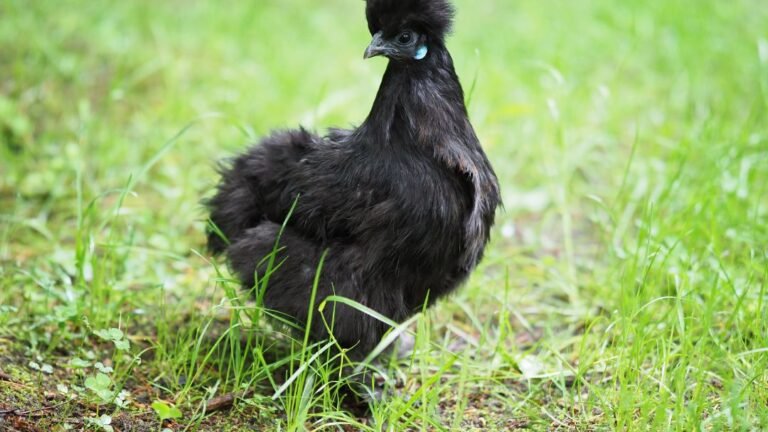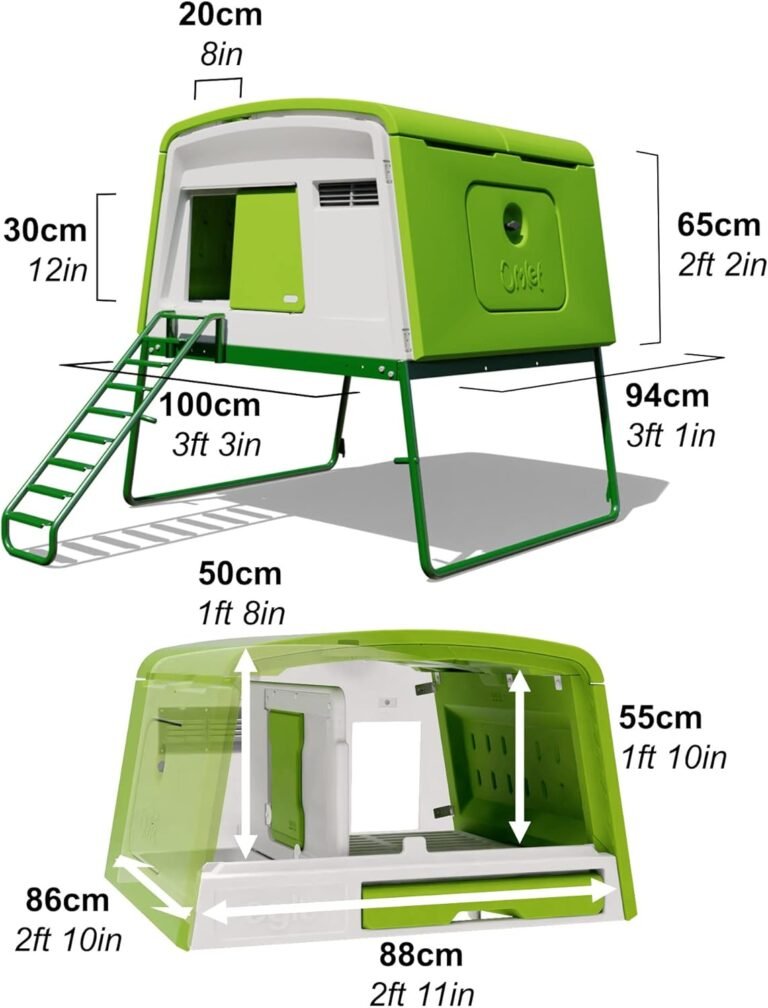Chickens are typically around 20 inches tall, standing on average between 15 and 18 inches. Chickens, those feathered creatures that bring us fresh eggs and succulent thighs, come in a variety of shapes and sizes.
But when it comes to their height, these poultry pals tend to be relatively petite. Most chickens measure around 15 to 18 inches in height, with some reaching a maximum of approximately 20 inches. These measurements are taken from the ground to the top of their heads.
While they may not tower over us, chickens still possess a unique charm and play a vital role in the world of agriculture and domestic companionship. So let’s take a closer look at our feathered friends and discover more about these fascinating creatures.
The Height Of Different Chicken Breeds
When it comes to raising chickens, one of the things you may be curious about is how tall different chicken breeds can grow. It’s interesting to learn about the size variations among these feathery creatures. In this article, we will explore “The Height of Different Chicken Breeds” and look at the average heights of small, medium, and large chicken breeds.
The Average Height Of Small Chicken Breeds
If you’re planning to have a small flock or have limited space in your backyard, small chicken breeds could be the perfect choice for you. These petite chickens have a height range that is adorably small, making them easy to handle and care for. Typically, small chicken breeds measure between 8 to 12 inches in height.
The following table lists a few popular small chicken breeds along with their average height:
| Chicken Breed | Average Height (in inches) |
|---|---|
| Bantam | 8-10 |
| Silkie | 9-10 |
| Sebright | 9-10 |
The Average Height Of Medium Chicken Breeds
If you have a bit more space and are looking for chickens that are slightly larger in size, medium chicken breeds might be the right fit for you. These breeds are still manageable and can easily adapt to various living environments. On average, medium chicken breeds measure between 12 to 18 inches in height.
Here are a few examples of medium chicken breeds and their average heights:
- Rhode Island Red: 12-15 inches
- Wyandotte: 12-15 inches
- Australorp: 15-18 inches
The Average Height Of Large Chicken Breeds
If you have plenty of space or are considering raising chickens for meat production, large chicken breeds are worth considering. These breeds, known for their impressive size, require more space and may have specific nutritional needs. Generally, large chicken breeds measure over 18 inches in height.
Here are a few examples of large chicken breeds and their average heights:
- Jersey Giant: 20-26 inches
- Cochin: 18-20 inches
- Orpington: 18-22 inches
Now that you have a better idea of the heights of different chicken breeds, it’s important to remember that these measurements are averages. Individual chickens may vary slightly in height even within the same breed. By understanding their average heights, you can better plan for the space needed and ensure the comfort of your feathery friends.
Factors Affecting Chicken Height
Have you ever wondered how tall chickens can grow? While chickens are generally known for their small stature, their height can vary depending on a variety of factors. These factors include genetics and breed variations, nutritional factors and growth rate, as well as environmental factors and living conditions. In this article, we will explore each of these factors in detail.
Genetics And Breed Variations
When it comes to chicken height, genetics play a crucial role. Different breeds of chickens have varying heights due to their genetic makeup. Some breeds are known for being taller, while others are naturally smaller. As a result, chicken height can vary significantly depending on the breed. For instance, Brahma chickens are one of the tallest breeds, known for their impressive height reaching up to 30 inches (76 cm). On the other hand, bantam chickens, which are a smaller breed, typically reach only about 8 to 12 inches (20 to 30 cm) in height.
Nutritional Factors And Growth Rate
The nutrition chickens receive during their growth stage also plays a vital role in determining their height. Just like any living creature, chickens need a balanced diet to grow properly. A high-quality feed that contains essential nutrients such as protein, vitamins, and minerals is crucial for optimal growth. Proper nutrition ensures that chickens develop strong bones and muscles, which can contribute to their overall height. Additionally, the rate at which chickens grow can also impact their final height. Faster-growing chickens tend to be taller compared to those with slower growth rates.
Environmental Factors And Living Conditions
The environment in which chickens are raised can also affect their height. Chickens that are kept in cramped or overcrowded conditions may not have enough space to fully extend their bodies, which could limit their growth potential. Similarly, poor ventilation and high humidity can create an unfavorable environment for chickens and hinder their growth. On the other hand, chickens raised in spacious and well-ventilated coops with optimal living conditions are more likely to reach their full height potential.
In conclusion, the height of chickens is influenced by a combination of genetic factors, nutritional factors, and environmental conditions. While genetics and breed variations establish a baseline for height, proper nutrition and conducive living conditions are essential for chickens to reach their maximum height potential. By understanding these factors, poultry farmers and chicken enthusiasts can better promote healthy growth and ensure the well-being of their flock.
Chicken Height Comparisons To Other Animals
Have you ever wondered just how tall chickens can actually grow? In this intriguing section, we will explore chicken height comparisons to other animals, providing you with a fascinating insight into the different sizes of our feathered friends. Prepare to be amazed at how chickens stack up against domestic birds, small mammals, and larger animals!
Comparing Chicken Height To Domestic Birds
When it comes to measuring the height of chickens, we often find ourselves comparing them to other domestic birds to grasp a better understanding of their size. While chickens are generally smaller in stature compared to many domestic bird species, such as turkeys and geese, they certainly hold their own when it comes to their unique presence and charm.
To give you a better perspective, here’s a comparison of the average heights of popular domestic birds in inches:
| Domestic Bird | Average Height (inches) |
|---|---|
| Chicken | 18-24 |
| Turkey | 48-60 |
| Goose | 35-43 |
As you can see, chickens stand at an average height of 18-24 inches, making them significantly smaller than their turkey and goose counterparts. Nonetheless, chickens possess unique characteristics that make them stand out among their fellow domestic birds.
How Chickens Stack Up Against Small Mammals In Height
Now, let’s delve into a more intriguing comparison as we explore how chickens stack up against small mammals in terms of height. While chickens may not be much taller than small mammals, such as squirrels or rabbits, their stature is certainly quite different.
Consider these estimates of the average heights of common small mammals in inches:
- Squirrel: approximately 5-9 inches
- Rabbit: around 8-20 inches
- Chicken: 18-24 inches
As you can see, chickens are noticeably taller than both squirrels and rabbits. While it may be surprising to some, chickens indeed take the lead in height among these particular small mammals.
Understanding The Height Difference Between Chickens And Larger Animals
When it comes to comparing chickens to larger animals, such as cows or horses, the difference in height becomes more noticeable. While chickens may appear petite and compact, they still hold their own unique charm among these towering creatures.
Take a look at this comparison of the average heights of larger animals in hands:
- Cow: approximately 56-60 hands (56-60 inches)
- Horse: around 60-70 hands (60-70 inches)
- Chicken: 18-24 inches
As you can see, chickens are considerably smaller compared to both cows and horses. This contrast in height emphasizes the fascinating diversity in the animal kingdom, where even the smallest creatures can make a significant impact in their own way.
In conclusion, while chickens may not be the tallest animals in the kingdom, they certainly hold their own unique stature and presence. From comparing their heights to other domestic birds to small mammals and even larger animals, it’s remarkable to see the variation in size across different species. Understanding these height differences allows us to appreciate the diverse and wonderful world of animals around us.
How To Measure The Height Of Chickens
When it comes to understanding the physical characteristics of chickens, their height often becomes a point of interest. Measuring the height of a chicken, however, can be a tricky task. These feathered creatures are constantly on the move, making it difficult to get an accurate measurement. But fear not! With the right tools and techniques, you can determine the height of a chicken with precision. This article will guide you through the process, discussing the tools and techniques for accurate height measurements, common challenges that may arise, and tips for obtaining consistent measurements.
Tools And Techniques For Accurate Height Measurements
When it comes to measuring the height of chickens, having the right tools and techniques is essential for accurate results. Let’s explore some of the options:
1. Measuring Tape:
A measuring tape is a simple and effective tool for measuring the height of chickens. Start by finding a flat surface and gently place the chicken on it, ensuring it remains calm. Then, measure from the ground to the highest point of the chicken’s back, usually near the base of the neck. Hold the measuring tape upright against the chicken and record the measurement in inches or centimeters.
2. String and Ruler:
If you don’t have a measuring tape on hand, a string and ruler can also serve the purpose. Take a string and wrap it around the chicken’s body at the base of the neck, where the highest point is. Mark the length of the string with a pen or clip and then measure it against a ruler. This method provides a reliable estimate of the chicken’s height.
Common Challenges In Measuring Chicken Height
Measuring the height of chickens can present some challenges due to their active nature and tendency to move around. Here are a few common obstacles you may encounter:
- Restlessness: Chickens tend to be restless when handled or confined. Their movements can make it challenging to get an accurate measurement. Try to ensure the chicken is calm and relaxed before attempting to measure its height.
- Inaccurate Posture: Chickens have the ability to change their posture, which can affect height measurements. For consistent results, make sure that the chicken stands upright with its back straight.
- Feather Density: Chickens’ feathers can be thick and fluffy, which may make it difficult to determine their actual height. Take care to measure from the highest point of their back, rather than including the height of their feathers.
Tips For Obtaining Consistent Measurements
To ensure consistent measurements of chicken height, consider the following tips:
- Standardize Positioning: Establish a consistent positioning for the chicken during measurements. Encourage the chicken to stand upright with its back straight for accurate readings.
- Take Multiple Measurements: To account for any variations or inaccuracies, take multiple measurements of the chicken’s height. This will help you obtain an average height and increase the overall accuracy of your findings.
- Minimize External Factors: Try to measure the chicken’s height in a controlled environment with minimal distractions. This will help reduce any external factors that may affect the chicken’s posture or behavior during the measurement process.
The Impact Of Chicken Height On Practical Matters
When it comes to raising chickens, their height plays a crucial role in various practical matters. From designing the perfect coop to maximizing egg production and protecting against predators, understanding the impact of chicken height is a fundamental aspect of poultry husbandry. In this blog post, we will explore the relationship between chicken height and practical considerations, highlighting the importance of height in coop design, egg production, and predator-prevention strategies.
Chicken Height And Coop Design Considerations
When designing a chicken coop, considering the height of your chickens is essential for their comfort and overall well-being. Chickens require enough vertical space for proper ventilation, movement, and roosting. Moreover, a taller coop provides ample room for the installation of horizontal perches, ramps, and nesting boxes. By ensuring sufficient headroom, you not only allow your chickens to exhibit natural behaviors like stretching and flapping their wings but also facilitate ease of cleaning and maintenance.
Additionally, many coop designs include elevated sections with multiple levels, allowing chickens to explore and perch at different heights. This vertical space utilization can maximize coop capacity, making it a critical consideration for backyard chicken owners with limited space. It is important to note that the optimal height of a chicken coop depends on the specific breed or type of chickens you keep, as different breeds have varying average heights.
The Relationship Between Height And Egg Production
The height of chickens can also influence their egg production. Research shows that older hens tend to lay eggs on elevated surfaces within the coop, such as higher roosts or nesting boxes. Providing these elevated options not only encourages natural egg-laying behaviors but also helps protect the eggs from potential damage caused by other chickens or floor-level predators. By incorporating higher perches or nesting boxes, you create a comfortable and safe environment that promotes productive egg-laying.
Moreover, chickens that have access to elevated perches during the night often experience better sleep quality, which directly impacts their overall health and egg production. A relaxed and well-rested chicken is more likely to produce quality eggs consistently.
The Significance Of Height In Predator-prevention Strategies
Height plays a vital role in preventing predator attacks on chickens. Elevating the coop off the ground significantly reduces the likelihood of predators such as raccoons, foxes, or stray cats gaining access. By adding height, you create an additional barrier that predators must surmount, making it more challenging for them to breach the coop.
Furthermore, incorporating features like a predator-proof run with a covered top or using fences with a height that exceeds the predator’s leap capabilities can enhance the effectiveness of your predator-prevention strategies. By maintaining a sufficient height in these protective measures, you minimize the risk of predation and provide a secure haven for your chickens to roam and forage.
By recognizing the impact of chicken height on practical matters, you can optimize coop design, foster efficient egg production, and enhance predator-prevention techniques. Taking these considerations into account ensures the well-being and safety of your flock while promoting a healthy and productive environment for your feathered friends.
Conclusion
Understanding the average height of chickens is essential for anyone interested in raising or studying these fascinating creatures. By knowing their size, you can better plan their living quarters, ensure their safety, and provide them with a comfortable environment. Remember, chickens come in different breeds, so their heights may vary.
By researching specific breeds, you can gain a deeper understanding of the height range for a particular chicken. Start exploring the world of chickens today and witness firsthand how these amazing animals thrive in different environments.



